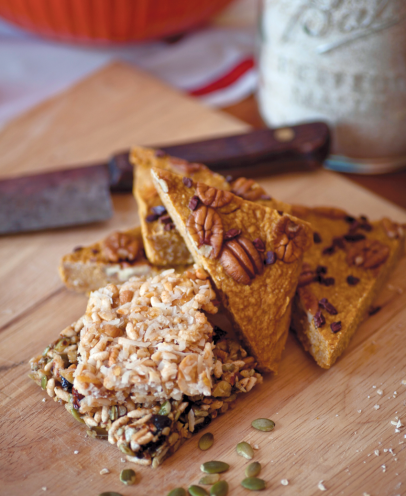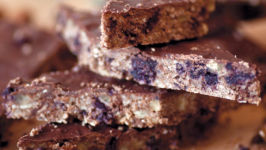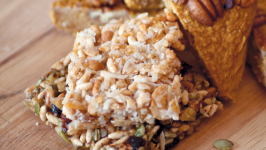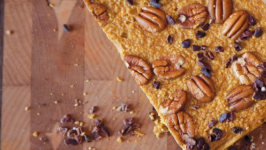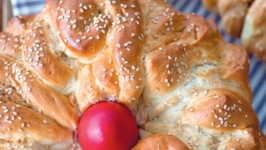Snack Attack!
I think we need to be honest with ourselves. We all have those days: slept through the alarm, the kids are crabby, the coffee maker just broke and Fido piddled on the dining room carpet. Sigh. Forget about those farm-fresh eggs in the fridge or the buckwheat pancakes that cha-cha’d through your morning dreams. Nope, this is the morning you grab a protein or granola bar and get on with the day.
Pre-made snack bars are an easy way to get a nutritional fix in a hurry. The challenge, of course, is navigating the myriad brands and types without a PhD in Chemistry and an endless supply of gold coins. Here’s the secret Nestle and Kellogg’s doesn’t want you to know: you can make protein bars at home. Really. It’s fast, cheap, and easy, once you understand the basic concepts.
The real value-added incentive is that crafting your own bars lets you develop them any way you want. Want them to be gluten-free? Easy. Want them nut-free? Easy. A small, picky eater living in your home would rather have their head spin around than eat a blueberry? You can make bars any way you want them.
Granola bars have their origin in the natural food movement that began in Germany in the mid-1800s and spread to North America. The theory was that the European-style diet of the time, heavy in meats and dairy, when combined with the sedentary lifestyle brought on by the move from rural farms to city factories, was detrimental to both physical and mental health. Sound familiar?
Early health proponents extolled the virtues of foods from the earth eaten in moderation. German and Swiss immigrants brought these ideas to Canada and the U.S., where they took firm root in the form of whole grain cereals. When we think of Kellogg’s today it’s difficult to imagine the first Dr. Kellogg at his Battle Creek Sanitarium coaxing folks to eat their oats. Nutritional scientists will argue the finer points of energy absorption from food but we do know that a balance of fats, carbohydrates and proteins are the key.
It’s also the key to great taste. One of the more common complaints about protein bars is the bad taste (in addition to the price). The added proteins used in bars are derived from whey and/or soy, and it really tastes lousy. Sure, there are vanilla, chocolate and strawberry flavors, but those are only chemical masks designed to disguise the taste. Manufacturers then try to further amp taste by loading the product with sugar. At that point, any health benefits are entirely negated.
There are two distinct types of protein bars on the market. First are the chocolate-covered, nut-based bars with added whey/soy proteins. These can have a thick, mealy-mouth feel and are loaded with sugar. At an average of 300 calories with 25 grams of sugar, these are better suited to Olympic weightlifters than the average eater.
So our healthy, homemade bars need to meet four criteria: 1) Taste great; 2) Lower in sugar, using natural sweeteners; 3) Affordable (cheaper than storebought bars); and 4) Made quickly and easily.
I experimented with the traditional protein bar recipe: a mix of peanuts, peanut butter, coconut oil, and whey protein powder all while reducing the sugars without resorting to artificial chemical sweeteners. The ratings from my tasters were not just bad, they were terrible. The fatal flaw is the whey/soy protein minus the sugar. Sure, there are folks out there who swear by their daily protein shakes and will tell you how great it tastes; I think they’re lying.
One of the great joys of being human is our ability to savor the taste of the foods we consume to keep the body alive. So working on the premise that anyone eating these bars needed to enjoy eating them, I looked to the second type of protein bar. These are constructed with a base of grains, fruits, and nuts, which render lots of taste without without adding sugar.
I needed professional advice. Eric Gesell is the Personal Wellness Manager at Outpost Food Co-Op, Bay View. I explained my dilemma and he had the perfect solution. A newer product in the supplement market is Rice Bran Protein. Wholly derived from sprouted brown rice, this product fit our specifications. It’s also 100% vegan, which gives us flexibility in addressing food allergies and other dietary restrictions. It is also available in a small selection of flavors, but in testing, the unflavored plain version produced the best results.
An added benefit was the cost: the standard 600-gram container averages $18. Each recipe uses 120 grams of protein, meaning one container will make 5 to 6 recipes. When factoring the cost of other ingredients, this brings the individual bar cost to 50 to 80 cents (depending on final ingredient choices)—far cheaper than purchasing pre-made bars at up to $3 each.
Energy and protein bars are a great solution for busy people, because they are so convenient. Any process to make them must be nearly as fast and simple. I normally shy away from cooking projects that require specialized equipment, but on this occasion I relented. A food processor is the secret to making protein bars fast and easy. You can make these without one, but you’ll lose the time savings (and you’d be chopping for hours until your forearms are as big as Popeye’s!).
Like many households, mine contains people who have restricted diets. Some of you might also experience the culinary challenge of cooking multiple meals or variations to suit all needs and tastes. The recipes included here are all vegetarian and with a small modification, vegan. They also allow for changes to accommodate nut allergies. Ultimately, taste was the driving factor for a recipe to make the grade. All tasters, many without knowing these had added protein or were even ‘low-sugar’, rated them much higher than their comparable commercial versions. I think this recipe, with its many fun variations, is a winner.
*When factoring the cost of other ingredients, this brings the individual bar cost to 50 to 80 cents (depending on final ingredient choices)—far cheaper than purchasing pre-made bars at up to $3 each.


